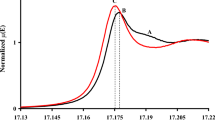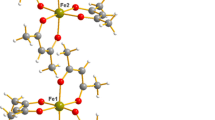Abstract
Recent quantitative electron paramagnetic resonance spectroscopy (EPR) data on different copper species present in copper exchanged CHA zeolites are presented and put into context with the literature on other copper zeolites. Results presented herein were obtained using ex situ and in situ EPR on copper ion exchanged into a CHA zeolite with Si/Al = 14 ± 1 to obtain Cu/Al = 0.46 ± 0.02. The results shed light on the identity of different copper species present after activation in air. Since the EPR signal is quantifiable, the content of the different EPR active species has been elucidated and Cu2+ in 2Al positions in the 6-membered rings (6mr) of the CHA structure has been characterized. Some copper species are found not to give an EPR signal at ambient or high temperatures. Fortunately, treatments with different gasses under in situ conditions are able to trigger an EPR signal and thus reveal information about the reactivity and the quantity of some of the otherwise EPR silent species. In this way the [Cu–OH]+ species in copper substituted low-Al zeolites has been indirectly observed and quantified. EPR active Cu2+ species have been followed under reduction and oxidation with gas mixtures relevant for the selective catalytic reduction of NO with NH3 (NH3-SCR) revealing that all Cu2+ in 6mr are easily reduced and oxidized at 200 °C. Furthermore, a stable [Cu–NO3]+ species is identified in Cu-CHA after exposure to NO and O2, but is not stable in 2Al 6mr sites of the CHA structure under the applied conditions.






Similar content being viewed by others
References
Gao F, Kwak JH, Szanyi J, Peden CHF (2013) Current understanding of Cu-exchanged chabazite molecular sieves for use as commercial diesel engine DeNOx catalysts. Top Catal 56:1441–1459
Beale AM, Gao F, Lezcano-Gonzalez I et al (2015) Recent advances in automotive catalysis for NOx emission control by small-pore microporous materials. Chem Soc Rev 44:7371–7405
Deka U, Lezcano-Gonzalez I, Weckhuysen BM, Beale AM (2013) Local environment and nature of Cu active sites in zeolite-based catalysts for the selective catalytic reduction of NOx. ACS Catal 3:413–427
EU Commission (2011) Commission Regulation (EU) No 582/2011 of 25 May 2011. Off J Eur Union L 167: 1
Meier WM, Olson DH, Baerlocher C (1996) Atlas of zeolite structure types. Zeolites 17:1–230
Iwamoto M, Hamada H (1991) Removal of nitrogen monoxide from exhaust gases through novel catalytic processes. Catal Today 10:57–71
Kwak JH, Tonkyn RG, Kim DH et al (2010) Excellent activity and selectivity of Cu-SSZ-13 in the selective catalytic reduction of NOx with NH3. J Catal 275:187–190
Janssens TVW, Falsig H, Lundegaard LF et al (2015) A consistent reaction scheme for the selective catalytic reduction of nitrogen oxides with ammonia. ACS Catal 5:2832–2845
Paolucci C, Verma A, Bates S et al (2014) isolation of the copper redox steps in the standard selective catalytic reduction on Cu-SSZ-13. Angew Chem Int Ed 53:11828–11833
Gao F, Walter ED, Kollar M et al (2014) Understanding ammonia selective catalytic reduction kinetics over Cu/SSZ-13 from motion of the Cu ions. J Catal 319:1–14
Giordanino F, Vennestrøm PNR, Lundegaard LF et al (2013) Characterization of Cu-exchanged SSZ-13: a comparative FTIR, UV-Vis, and EPR study with Cu-ZSM-5 and Cu-β with similar Si/Al and Cu/Al ratios. Dalton Trans 42:12741–12761
Godiksen A, Stappen FN, Vennestrøm PNR et al (2014) Coordination environment of copper sites in Cu-CHA zeolite investigated by electron paramagnetic resonance. J Phys Chem C 118:23126–23138
Andersen CW, Bremholm M, Vennestrøm PNR et al (2014) Location of Cu 2+ in CHA zeolite investigated by X-ray diffraction using the Rietveld/maximum entropy method. IUCrJ 1:382–386
Stoll S, Schweiger A (2006) EasySpin, a comprehensive software package for spectral simulation and analysis in EPR. J Magn Reson 178:42–55
Addison AW, Yokoi H (1977) Spectroscopic and redox properties of pseudotetrahedral copper (II) complexes. Their relationship to copper proteins. Inorg Chem 16:1341–1349
Peisach J, Blumberg WE (1974) Structural implications derived from the analysis of electron paramagnetic resonance spectra of natural and artificial copper proteins. Arch Biochem Biophys 165:691–708
Sakaguchi U, Addison AW (1979) Spectroscopic and redox studies of some copper(II) Complexes with bio- mimetic donor atoms : implications for protein copper centres. J Chem Soc Dalton Trans 4:600–608
Carl PJ, Larsen SC (2000) EPR study of copper-exchanged zeolites: effects of correlated g- and A-strain, Si/Al ratio, and parent zeolite. J Phys Chem B 104:6568–6575
Carl PJ, Larsen SC (1999) Variable-temperature electron paramagnetic resonance studies of copper-exchanged zeolites. J Catal 182:208–218
Öpik U, Pryce MHL (1957) Jahn–Teller effect. I. A survey of the static problem. Proc R Soc Lond A 238:425–447
Jahn HA, Teller E (1937) Stability of polyatomic molecules in degenerate electronic states. I. Orbital degeneracy. Proc R Soc Lond A 161:220–235
Bendix J (2004) Ligfield. Compr Coord Chem 2:673–676
Piligkos S, Bendix J, Weihe H et al (2008) A ligand-field study of the ground spin-state magnetic anisotropy in a family of hexanuclear Mn(III) single-molecule magnets. Dalton Trans 17:2277–2284
Broser I, Schulz M (1969) Elektronenspinresonanz an Kupferdozierten ZnO-Einkristallen. Solid State Commun 7:651–655
Narayana M, Kevan L (1983) Detection of a new trigonal bipyramidal copper species in Cu–CaX zeolite by electron spin resonance and electron spin echo modulation analysis. J Chem Phys 78:3573–3578
Vanelderen P, Vancauwenbergh J, Sels BF, Schoonheydt RA (2013) Coordination chemistry and reactivity of copper in zeolites. Coord Chem Rev 257:483–494
Dědeček J, Kaucký D, Wichterlová B (2000) Co2+ ion siting in pentasil-containing zeolites, part 3. Co2+ ion sites and their occupation in ZSM-5: a VIS diffuse reflectance spectroscopy study. Micropor Mesopor Mater 35–36:483–494
Conesa JC, Soria J (1979) Electron spin resonance of copper-exchanged Y zeolites. J Chem Soc Faraday Trans 1(75):291–293
Nicula A, Stamires D, Turkevich J (1965) Paramagnetic resonance absorption of copper ions in porous crystals. J Chem Phys 42:3684–3692
Kucherov A, Gerlock J (1994) In situ determination by esr of the oxidation state of copper in Cu-ZSM-5 in flowing He and O2 up to 500 °C. J Phys Chem 98:4892–4894
Kucherov AV, Slinkin AA (1989) Change of Cu(II) cation coordination in H-ZSM-5 channels upon the sorption of n-hexane and xenon: ESR spectroscopic evidence. J Phys Chem 93:864–867
Gao F, Walter ED, Karp EM et al (2013) Structure–activity relationships in NH3-SCR over Cu-SSZ-13 as probed by reaction kinetics and EPR studies. J Catal 300:20–29
Larsen SC, Aylor A, Bell AT, Reimer JA (1994) Electron paramagnetic resonance studies of copper ion-exchanged ZSM-5. J Phys Chem 98:11533–11540
Anderson MW, Kevan L (1987) Study of Cu2+-doped zeolite NaH-ZSM-5 by electron spin resonance and electron spin echo modutation spectroscopies. J Phys Chem 91:4174–4179
Kucherov A, Gerlock J, Jen H, Shelef M (1995) In situ esr monitoring of the coordination and oxidation states of copper in Cu-ZSM-5 up to 500 °C in flowing gas mixtures: 1. Interaction with He, O2, NO, NO2 and H2O. Zeolites 15:9–14
Pierloot K, Delabie A, Groothaert MH, Schoonheydt RA (2001) A reinterpretation of the EPR spectra of Cu(II) in zeolites A, Y and ZK4, based on ab initio cluster model calculations. Phys Chem Chem Phys 3:2174–2183
Vanelderen P, Vancauwenbergh J, Tsai M-L et al (2014) Spectroscopy and redox chemistry of copper in mordenite. ChemPhysChem 15:91–99
Oliva C, Selli E, Ponti A et al (1997) FTIR and EPR characterisation of copper-exchanged mordenites and beta zeolites. J Chem Soc Faraday Trans 93:2603–2608
Borfecchia E, Lomachenko KA, Giordanino F et al (2015) Revisiting the nature of Cu sites in the activated Cu-SSZ-13 catalyst for SCR reaction. Chem Sci 6:548–563
Shwan S, Skoglundh M, Lundegaard LF et al (2014) Solid-state ion-exchange of copper into zeolites facilitated by ammonia at low temperature. ACS Catal 5:16–19
Yu J-S, Kevan L (1990) Temperature dependence of copper(II) migration and formation of new copper(II) species during catalytic propylene oxidation on copper(II)-exchanged Y zeolite and comparison with X zeolite. J Phys Chem 94:7612–7620
Seo SM, Lim WT, Seff K (2012) Crystallographic verification that copper(II) coordinates to four of the oxygen atoms of zeolite 6-rings. Two single-crystal structures of fully dehydrated, largely Cu2+ exchanged zeolite Y (FAU, Si/Al = 1.56). J Phys Chem C 116:963–974
Deka U, Eilertsen EA, Emerich H et al (2012) Confirmation of isolated Cu2+ ions in SSZ-13 zeolite as active sites in NH3-selective catalytic reduction. J Phys Chem C 116:4809–4818
Groothaert MH, Pierloot K, Delabie A, Schoonheydt RA (2003) Identification of Cu(II) coordination structures in Cu-ZSM-5, based on a DFT/ab initio assignment of the EPR spectra. Phys Chem Chem Phys 5:2135–2144
De Tavernier S, Schoonheydt RA (1991) Coordination of Cu2+ in synthetic mordenites. Zeolites 11:155–163
Kucherov AV, Slinkin AA, Kondrat’ev DA et al (1985) Cu2+-cation location and reactivity in mordenite and ZSM-5: esr-study. Zeolites 5:320–324
Bates SA, Verma AA, Paolucci C et al (2014) Identification of the active Cu site in standard selective catalytic reduction with ammonia on Cu-SSZ-13. J Catal 312:87–97
Göltl F, Bulo RE, Sautet P (2013) What makes copper-exchanged SSZ-13 zeolite efficient at cleaning car exhaust gases? J Phys Chem Lett 4:2244–2249
Göltl F, Sautet P, Hermans I (2016) The impact of finite temperature on the coordination of Cu cations in the zeolite SSZ-13. Catal Today 267:41–46
Delabie A, Pierloot K, Groothaert MH et al (2001) The siting of Cu(II) in mordenite: a theoretical spectroscopic study. Phys Chem Chem Phys 4:134–145
Moreno-González M, Hueso B, Boronat M et al (2015) Ammonia-containing species formed in Cu-chabazite as per in situ EPR, solid-state NMR, and DFT calculations. J Phys Chem Lett 6:1011–1017
Packet D, Dehertogh W, Schoonheydt RA (1985) Spectroscopy of Cu(II) coordinated to lattice oxygens in zeolites. In: Drzaj B, Hocevar S, Pevojnik S (eds) Zeolites: synthesis, structure, technology, and application. Elsevier, Amsterdam, pp 351–358
Schoonheydt RA (1993) Transition metal ions in zeolites: siting and energetics of Cu2+. Catal Rev 35:129–168
LoJacono M, Fierro G, Dragone R et al (1997) Zeolite chemistry of CuZSM-5 revisited. J Phys Chem B 5647:1979–1984
Conesa JC, Soria J (1978) Electron spin resonance of undetected copper(II) ions in Y zeolite. J Phys Chem 82:1847–1850
Valyon J, Hall WK (1993) On the preparation and properties of CuZSM-5 catalysts for NO decomposition. Catal Lett 19:109–119
Verma AA, Bates SA, Anggara T et al (2014) NO oxidation: a probe reaction on Cu-SSZ-13. J Catal 312:179–190
Gao F, Wang Y, Washton NM et al (2015) Effects of alkali and alkaline earth cocations on the activity and hydrothermal stability of Cu/SSZ-13 NH 3 -SCR catalysts. ACS Catal 5:6780–6791
Günter T, Carvalho H, Doronkin DE et al (2015) Structural snapshots of the SCR reaction mechanism on Cu-SSZ-13. Chem Commun 51:9227–9230
Kieger S, Delahay G, Coq B, Neveu B (1999) Selective catalytic reduction of nitric oxide by ammonia over Cu-FAU catalysts in oxygen-rich atmosphere. J Catal 183:267–280
Kwak JH, Lee JH, Burton SD et al (2013) A common intermediate for N2 formation in enzymes and zeolites: side-on Cu-nitrosyl complexes. Angew Chem Int Ed Engl 52:9985–9989
Acknowledgments
This work was financially supported by the Danish Independent Research Council DFF—1335-00175. The Carlsberg Foundation is acknowledged for supporting the upgrade of the EPR instrument at DTU Chemistry.
Author information
Authors and Affiliations
Corresponding author
Rights and permissions
About this article
Cite this article
Godiksen, A., Vennestrøm, P.N.R., Rasmussen, S.B. et al. Identification and Quantification of Copper Sites in Zeolites by Electron Paramagnetic Resonance Spectroscopy. Top Catal 60, 13–29 (2017). https://doi.org/10.1007/s11244-016-0731-7
Published:
Issue Date:
DOI: https://doi.org/10.1007/s11244-016-0731-7




